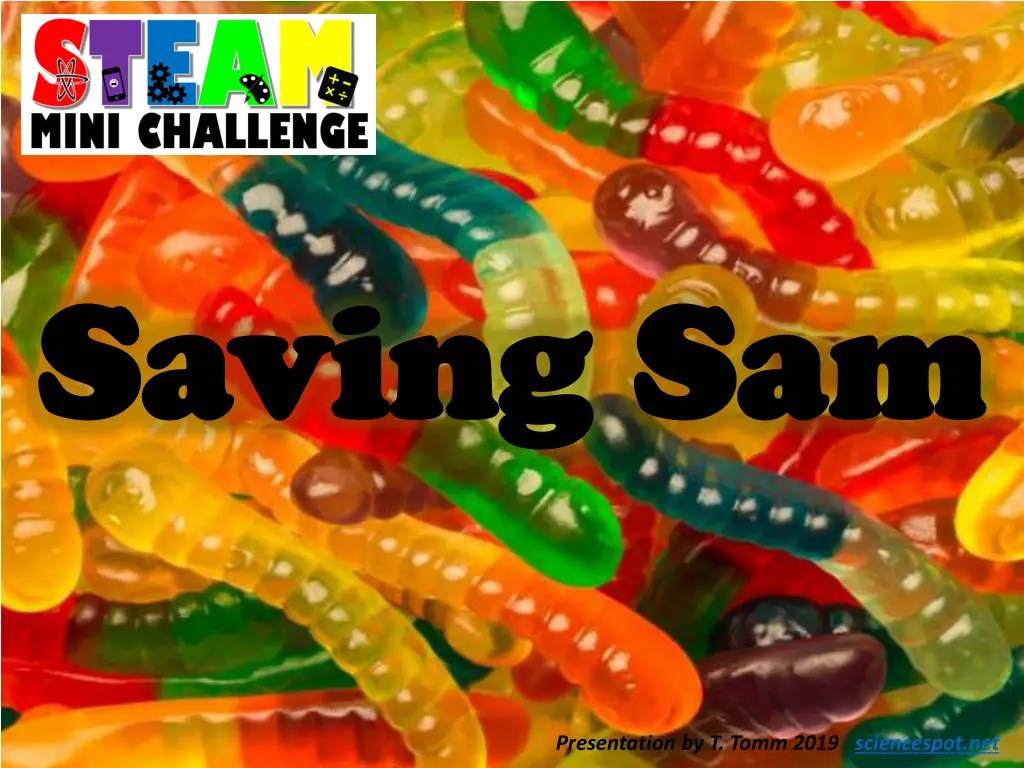
Save Sam Activity Challenge
Engage in the "Save Sam" challenge where you must rescue Sam using only paperclips as tools to retrieve his life jacket. Explore gummy bear science and an extension activity involving documenting the effects of water on gummy candy. Get hands-on with measurements and calculations for a fun and educational experience.
Download Presentation

Please find below an Image/Link to download the presentation.
The content on the website is provided AS IS for your information and personal use only. It may not be sold, licensed, or shared on other websites without obtaining consent from the author. If you encounter any issues during the download, it is possible that the publisher has removed the file from their server.
You are allowed to download the files provided on this website for personal or commercial use, subject to the condition that they are used lawfully. All files are the property of their respective owners.
The content on the website is provided AS IS for your information and personal use only. It may not be sold, licensed, or shared on other websites without obtaining consent from the author.
E N D
Presentation Transcript
Saving Sam Saving Sam Presentation by T. Tomm 2019 sciencespot.net
Can your team save Sam? Can your team save Sam? Help me! Sam s boat has capsized and he cannot swim. He managed to slither/float to the top of the overturned boat, but his life preserver is stuck under the boat. Set up this scenario using the cup as the boat, the gummy worm as Sam, and the life saver as the life preserver. Click to see if you are correct! He needs his life jacket so that he can float all the way to shore. You and your partner must save Sam by fetching the life jacket from under the boat and then put it on Sam so it will not slip off. The challenge the only tools you can use to accomplish this task are paperclips. You cannot touch Sam, the boat, or the life preserver with your hands or any other object except the paperclips.
Discuss It Discuss It 1. How did you save Sam? Was there more than one way that would work? 2. Could you have completed the challenge alone? Why or why not? 3. How could you make this activity more challenging?
How Its Made How It s Made What are the main ingredients in gummy bears? What makes a gummy bear a gummy bear? Where does this substance come from? Besides malic acid, what other acid is added? Why? What shape is the finished molecule? https://madison.com/lifestyles/blue-sky-science-how-are-gummy- bears-made/video_c7388fe9-61b5-5172-8d2e-f3484c3011f6.html This Photo by Unknown Author is licensed under CC BY
Extension Activity What would happen to a gummy candy if it is put in water and left overnight? Write your hypothesis on your worksheet. How could we document this scientifically? Worksheet available at https://sciencespot.net/Media/mmaniabearlab.pdf
Part A: Choose one gummy bear from the container on your table. Use the equipment available to measure your gummy bear and record the data in the chart for Day 1.
Measurements: The length of your gummy bear should be measured from the top of its head to the bottom of its feet to the nearest tenth of a centimeter. Measure the width at the widest point across the back of the bear to the nearest tenth of a centimeter. Measure the thickness from the front to the back at the thickest point to the nearest tenth of a centimeter. Calculate the volume by multiplying the length, width, and thickness. Round to the nearest hundredth. Measure the mass using a triple-beam balance or other scale to the nearest tenth of a gram. Calculate the density by dividing the mass by the volume. Round answer to the nearest hundredth
Part B: Put the bear in a cup labeled with your name and class period. Label a cup with your name and add 50 ml of water to it. Put it in the correct area and allow it to sit overnight. Use a graduated cylinders to measure 50 ml of water. Make sure the measurement based on the bottom of the meniscus or curve. You need to be eye-level with the level of the water. What causes the meniscus? A concave meniscus occurs when the molecules of the liquid attract those of the container. The glass attracts the water on the sides.
Part B: Put the bear in a cup labeled with your name and class period. Add 50 ml of water to the cup and allow it to sit overnight. On Day 2, remove the gummy bear from the cup of water and use a towel to dry it off to prevent it from dripping all over the place. Repeat the measurements from Part A and record your data in the correct portion of the chart. Determine the amount of change for each measurement and record in the chart.
Questions: Write an answer to each question on your worksheet. You may discuss them with your tablemates. 1. Was your hypothesis correct? Why or why not? 2. Which change is greater - volume or mass? Explain. 3. Was there a change in density? Why? 4. How do your results compare to those of your classmates?
